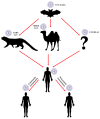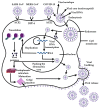A new threat from an old enemy: Re‑emergence of coronavirus (Review)
- PMID: 32236624
- PMCID: PMC7169834
- DOI: 10.3892/ijmm.2020.4555
A new threat from an old enemy: Re‑emergence of coronavirus (Review)
Abstract
The new outbreak of coronavirus from December 2019 has brought attention to an old viral enemy and has raised concerns as to the ability of current protection measures and the healthcare system to handle such a threat. It has been known since the 1960s that coronaviruses can cause respiratory infections in humans; however, their epidemic potential was understood only during the past two decades. In the present review, we address current knowledge on coronaviruses from a short history to epidemiology, pathogenesis, clinical manifestation of the disease, as well as treatment and prevention strategies. Although a great amount of research and efforts have been made worldwide to prevent further outbreaks of coronavirus‑associated disease, the spread and lethality of the 2019 outbreak (COVID‑19) is proving to be higher than previous epidemics on account of international travel density and immune naivety of the population. Only strong, joint and coordinated efforts of worldwide healthcare systems, researchers, and pharmaceutical companies and receptive national leaders will succeed in suppressing an outbreak of this scale.
Figures
References
-
- Groot RJ, Baker SC, Baric R, et al. Family - Coronaviridae. In: Lefkowitz EJ, Adams MJ, Carstens EB, editors. Virus Taxonomy Ninth Report of the International Committee on Taxonomy of Viruses King AMQ. Elsevier; 2011. pp. 806–828.
Publication types
MeSH terms
LinkOut - more resources
Full Text Sources
Miscellaneous




